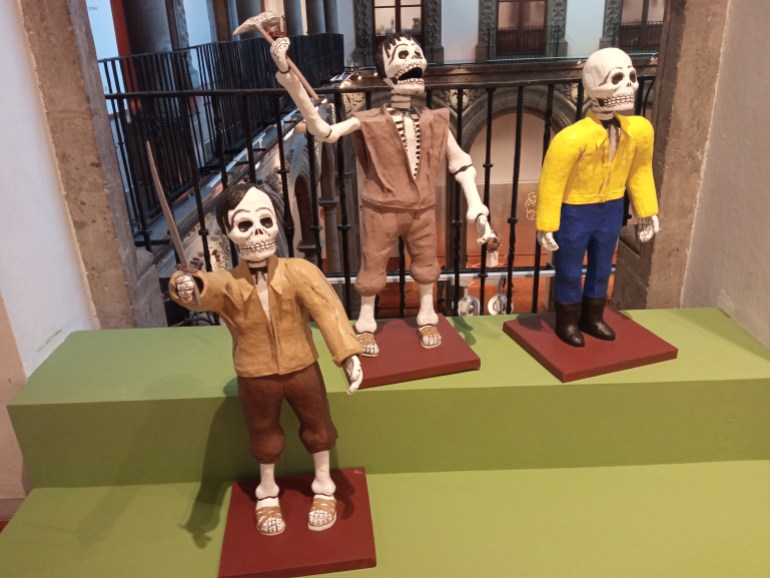Citigroup is selling Citibanamex whose assets include a vast collection of Mexican masterpieces.
By Ann Deslandes
Mexico City, Mexico – In the baroque Iturbide Palace in downtown Mexico City, some of the nation’s most precious homegrown art treasures can be found in the Fomento Cultural Citibanamex – the cultural development centre belonging to US financial giant Citigroup’s consumer banking arm in Mexico.
The current exhibition, which opened in November and runs until May, tells the story of Mexico’s fight for independence from Spain, from the first rallying of troops in 1810 to the country’s decisive secession from the colonial power in 1821.
Through papier-mâché skeleton figures and dioramas of silver and clay, the exhibit, titled ‘Independence through the great masters of Mexican popular art’, depicts various battles, victories, and scenes of everyday life in the country’s long journey to home rule.
That theme could not have proved more prescient. Because whether all of Fomento’s vast collection of Mexican masterpieces, including works by Frida Kahlo, Diego Rivera, José Clemente Orozco, and Leonora Carrington – will stay in Mexico has suddenly been thrown into doubt.
That is because on January 11, Citigroup announced it is leaving Mexico and putting Citibanamex up for sale – including the Fomento.
The Fomento’s assets include a significant Mexican art collection along with iconic real estate such as the Iturbide Palace and other grand edifices spread throughout the country. News of its impending sale has prompted fierce posturing and speculation.

Mexico’s foreign minister Marcelo Ebrard tweeted on January 16 that he believed the Fomento Cultural “should become national property for its preservation”. Domestic media outlets have buzzed with talk of ensuring the collection will be kept intact, and crucially – in Mexico.
Some of this hand wringing is rhetorical grandstanding. Many of the artworks in the Fomento’s collection are protected by Mexican federal laws that require items of national cultural importance to remain in the country.
In a press conference on January 13, Citibanamex corporate director Alberto Gómez Alcalá tried to alleviate fears that the Fomento’s treasures could end up abroad, stressing that its assets “will be an integral and indivisible part” of the “divestment and sale” of Citibanamex.
His comments to reporters suggest that there will be no compromise on keeping the Fomento’s treasure trove together and protected.
Still, as various potential buyers, such names as Mexican billionaire Ricardo Salinas, HSBC bank, Brazilian fintech startup Nubank, announce their interest in acquiring Citibanamex, speculation has abounded that the collection could still be broken up, with the works not protected by law leaving the country.
On January 26, Mexican President Andres Manuel Lopez Obrador said in his daily morning press conference that the bank ought to be owned by Mexicans and that his Treasury department was running the numbers on the exact value of its assets.
The collection and its significance
The Fomento’s art collection “undoubtedly stands out” among Latin American art collections, said art historian and cultural strategist Mariana Morales. From its founding in 1884 when Banamex was created, the collection has reflected Mexico’s nationalist spirit, with “the intention of reflecting what Mexico is” across time, Morales told Al Jazeera.
Moreover, the collection has had a pivotal role in promoting and preserving popular art in Mexico, including works currently displayed in the Independence exhibition. “They have transformed the category of these works that were commonly considered handicrafts into museum pieces,” said Morales.

The Fomento also houses “one of the most complete collections of 19th-century art”, she said. That has contributed extensively to research and documentation of this period in world history, thanks to “about 2,000 pictorial works ranging from the 18th to the 19th century, in a wide variety of techniques”.
For Mexico City residents Pablo Santiago Luna Torres and Leticia Rosas Aguilar, the Independence exhibition bears testament to the significance the Fomento’s collection holds for Mexico’s history and national identity.
The works “capture the history of Mexico, with Mexican folklore”, Rosas told Al Jazeera. “Independence is shown through skulls and skeletons, in different times and with different materials.”
“Death seems to be a taboo for some countries, but for us it relates to our life,” said Luna. “The works show that change, that time, and how it relates to independence.”
Rosas said it is “debatable” whether the Fomento’s collection should be bought and owned by the Mexican state or a Mexican company. “The truth is, many foreigners also … care a lot about Mexican culture.”
No matter who ends up buying the collection, Mariana Morales hopes that the Fomento continues to contribute “to the development, knowledge and dissemination of art and culture in Mexico”, while supporting and promoting works by Indigenous artists.
For her, that means keeping the collection intact, because dismantling it in any way would fundamentally alter “a historical and architectural collection that has been in the making for more than a century”, she said.
SOURCE: AL JAZEERA


